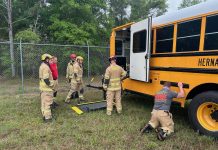When special needs transportation consultant Cheryl Wolf visited an Indiana school district in August to provide training on emergency bus evacuation drills, she heard the sound of crickets in response.
“They didn’t want to sit down and think about the population on the bus,” said Wolf, whose 30 years in student transportation includes serving as transportation supervisor at Lafayette (Ind.) School Corporation. “You could see the look on their faces that they didn’t want to go any further.”
Surprisingly, there are still school districts that don’t practice emergency bus evacuation drills. Charley Kennington is director of Houston-based Innovative Transportation Solutions, which offers customized training for school districts. He said one common hurdle he sees is how some districts approach, or don’t approach, the planning phase.
“Too many times people get into the thought of ‘this isn’t going to happen to me’,” he said. “But you just have to work through the process because in the event of an emergency, there is no time to plan at that moment.”
The planning phase generally begins by thinking of the “individual” — first the bus driver, then the monitor, and then each individual on a particular school bus route. Next comes thinking about how the bus driver would help a student get off the bus during an emergency. Last is thinking about the physical capabilities of each student passenger so she can help herself exit the bus as quickly and safely as possible, freeing the driver and/or monitor to help others.
“Then you have to back out and look at it from a bigger picture,” Kennington said. “Look at all of the students on a bus and find out how one can help the other.”
This thought process is then applied to each school bus with a different route. If the ridership on a route changes for any reason at any time, the evacuation plan for that route needs to be re-evaluated and updated.
Kennington said the main thing is paying particular attention to the student ridership. “Especially special needs, for which we dominantly provide these trainings and drills.”
This is why practicing as many times throughout the school year is so vital. Regularly conducting a drill will reinforce the training and sequence of events taught to all participants.
For students with special needs, student transporters should work with the IEP team to ensure the school bus environment is customized to meet their needs just as in the classroom, noted Sue Shutrump, supervisor of occupational therapy services for the Trumbull County Education Service Center in Ohio.
For physically challenged students, she said involving people in the planning phase who truly know their needs, such as a physical or occupational therapist, will help determine their ability to quickly and safely exit a bus. Shutrump emphasized that students bound to a wheelchair, in most cases, can be either lifted or dragged out of their chair in emergency situations per evacuation instructions in their Individualized Transportation Plan.
“There are many times when transporters will talk about evacuating a child in a wheelchair and that is not appropriate,” said Shutrump, and added it might also not be realistic. “Drivers need to realize that most of these students aren’t so fragile. Maybe they’ll come out of the bus with a minor broken bone, but it’s a heck of a lot of better than them not getting out.”
Youth with special needs may not physically participate in these evacuation drills, but young children certainly can. Wolf said how well children interact during these drills can also determine its success.
John Williams, transportation coordinator at E Center Head Start in Marysville, Calif., conducts monthly bus evacuation drills that include all of the center’s children, aged 3 to 5. They are all treated as special needs because of their door-to-door busing and because they are secured with integrated safety restraints on the bus. One drill for one school bus route takes about half an hour.
He said the children enjoy the drills as they get a chance to do something other than their normal classroom routine. They also at times turn the drill into a fun, friendly competition that doesn’t disrupt the practice.
“The [kids] get attached with bus personnel [though] they only spend a short amount of time with them during the day,” he said.
In the end, the bus driver is the ringleader when an actual event occurs resulting in an emergency bus evacuation. Regardless of their driving experience, these drills empower them to remember and rely on their training when their minds go blank and their adrenaline kicks in.
“That’s another good reason to actually physically go through the steps of the evacuation,” said Shutrump. “It’s confidence building.”
















